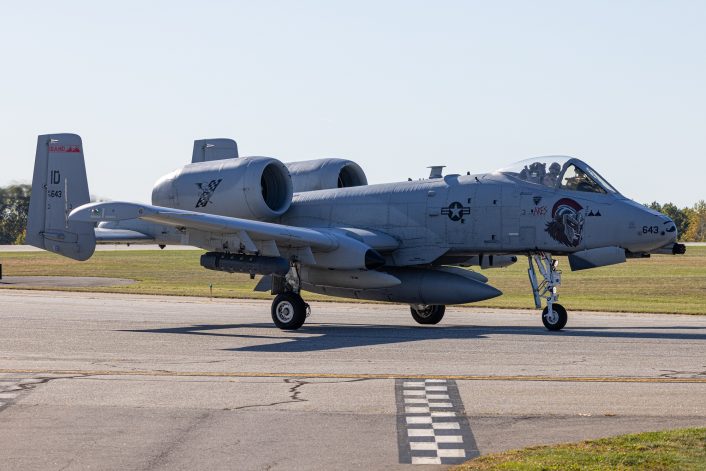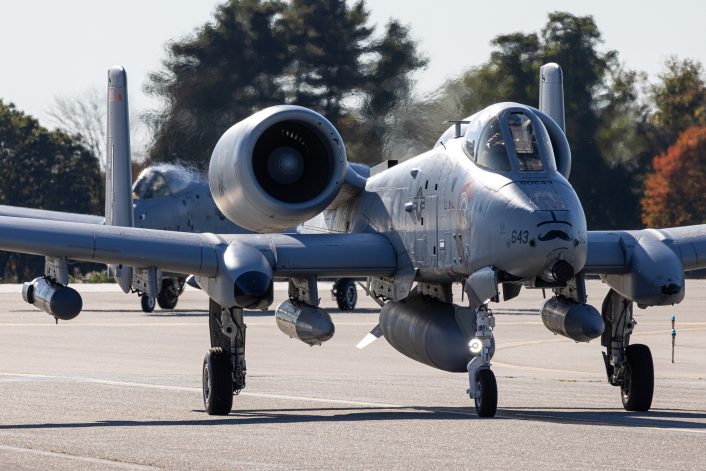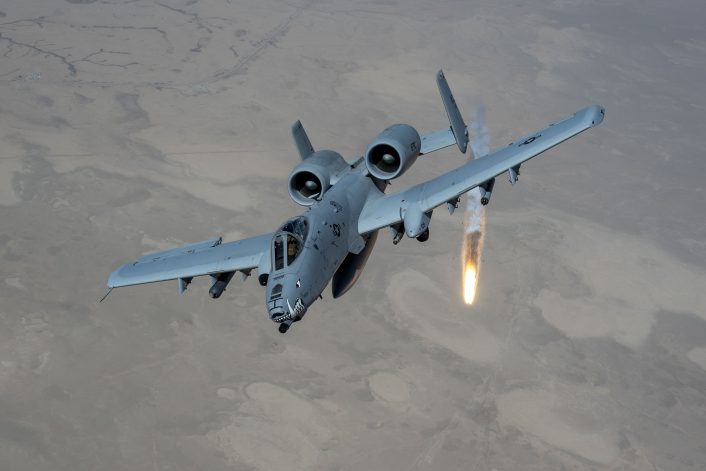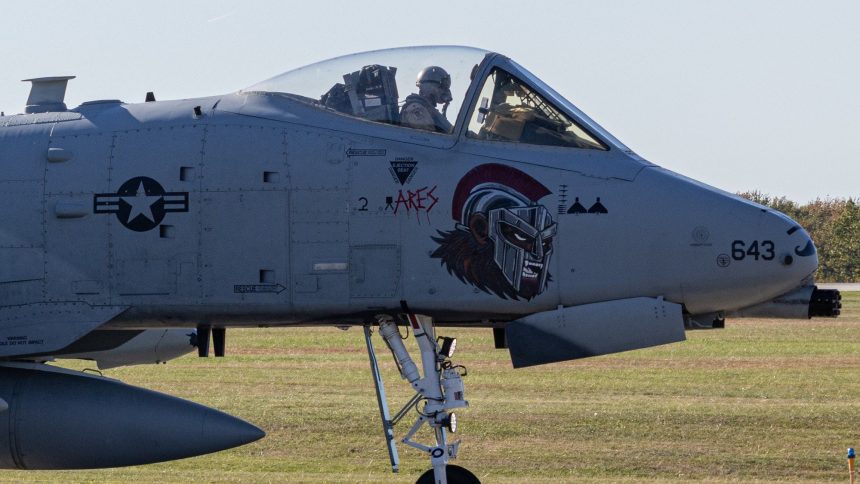An A-10C was spotted with two Shahed-type UAS shapes painted on the nose while returning to its home base.
An A-10C Thunderbolt II of the U.S. Air Force was spotted with two interesting kill markings while returning home from its latest deployment in the U.S. CENTCOM (Central Command) AOR (Area of Responsibility). In fact, the aircraft was painted with two Shahed-type UAS shapes on its nose, together with other kill markings and an Ares (the Greek God of War) figure.
These markings appear to be the first confirmation that the Warthog (as the aircraft is nicknamed within the fighter pilot community) has been used in a Counter UAS role and has shot down hostile One Way Attack (OWA) drones. No official statement has been released by the U.S. Air Force.
TABOR61 (mixed the callsigns on the first flight 😅) arriving at PSM after a trip from Lajes! pic.twitter.com/pJwwJAgtJL
— Alex (@mhtplanes) October 10, 2025
The photos
The 12 Warthogs were spotted arriving at Portsmouth International at Pease, New Hampshire, in two cells of six aircraft each on Oct. 7 and 10. The A-10 “Ares” was part of the second cell, and was captured while taxiing after landing by aviation photographer Alex H, who kindly shared the photos with us.

Alex told us in an email that each A-10 was painted with a figure representing a Greek god. Throughout the years, it became tradition that U.S. aircraft returning from deployment with decorative nose arts and markings representing the weapons employed and/or the targets.
On Oct. 7, the aircraft spotted were:
- TABOR71 A-10 79-0121 “Herme”
- TABOR72 A-10 79-0091 “NYX”
- TABOR73 A-10 79-0109 “Cronus”
- TABOR74 A-10 78-0707 “Artemis”
- TABOR75 A-10 79-0136 “Athena”
- TABOR76 A-10 80-0218 “Poseidon”
On Oct. 10, the aircraft spotted were:
- TABOR61 A-10 79-0122 “Dionysus”
- TABOR62 A-10 78-0643 “Ares”
- TABOR63 A-10 79-0152 “Demeter”
- TABOR64 A-10 79-0084 “Zeus”
- TABOR65 A-10 80-0276 “Hades”
- TABOR66 A-10 78-0624 “Aphrodite”
The deployment
The 124th Fighter Wing of the Idaho Air National Guard, stationed at Gowen Field Air National Guard Base, Idaho, deployed its A-10s to the CENTCOM AOR on Mar. 29, 2025, flown by the 190th Fighter Squadron. The six-month deployment was planned to last until the end of September, according to Idaho’s media.
In the past, the Warthog played an important role in combat operations against militants in Iraq and Syria. This time, the presence of the A-10 was silent, with few photos and statements documenting their presence in the area.

The photos showed the A-10s flying with a relatively light load, which included two GBU-54 Laser JDAM guided bombs and a LAU-131 A/A pod with seven AGR-20 rockets, also known as APKWS II (Advanced Precision Kill Weapon System). The latter, in the upgraded AGR-20F FALCO (Fixed-Wing Air-Launched Counter Unmanned Aerial Systems Ordnance) variant, is the weapon of choice for U.S. F-15Es and F-16Cs employed in a Counter-UAS role in the CENTCOM AOR.
As reported in July 2025 by The War Zone, Pentagon documentation for the 2026 budget explicitly mentioned the AGR-20F is cleared for use on the F-16, F-15E, and the A-10. As FALCO is a software modifications, the photos can’t be used to discern which variant was employed by the A-10 during the deployment, but it is reasonable to say it was the AGR-20F.
Many would ask why use the A-10, a slow aircraft built for Close Air Support, to intercept drones. The answer can be found in the captions of the U.S. Air Force used to describe the jet: “The A-10 can loiter near battle areas for extended periods of time and operate in low ceiling and visibility conditions.”
These capabilities make the Warthog ideal to efficiently tackle slow-moving drone threats, as it can stay airborne for hours, cheaply, and with the ability to carry lots of rockets, if needed, to stop large swarming attacks. This would bring down even more the price of shooting down the cheap Shahed drones and similar, instead of using costlier fighters, like the F-15, F-16 and F-35, with costlier weapons, like the AIM-9X and AIM-120C/D.
The A-10 could also use its powerful GAU-8 30mm cannon, however it would need to get closer to the targets, increasing the risk of ingesting debris.

The APKWS II
The rockets loaded on the launchers were identified as APKWS II, a type that has recently been introduced into the air-to-air domain being used by USAF F-16s to shoot down Houthi drones around the Red Sea. The APKWS II, which was first tested as an air-to-air weapon back in 2019, provides a cheap solution to engage both air and ground targets. In the counter drone role, the F-16s often operated in pairs with one jet ‘painting’ the target with a laser from the Sniper ATP while the other made an attack run with the rockets.
The recent introduction of the APKWS II as a counter-drone weapon for the F-16, which carried just one or two rocket launchers, effectively tripled its engagement opportunity when compared to previous loadouts featuring just six air-to-air missiles. The same happened with the F-15E, with both fighters able to carry up to 42 rockets.
This also drastically reduced the cost per kill: an AIM-9X costs about $450,000 and an AIM-120 more than $1 million, while a single APKWS II rocket is estimated to have a price point of around $30,000. However, its air-to-air target portfolio is limited to steady targets such as drones or cruise missiles; it is not able to maneuver as much as other specialized air-to-air weapons like the AIM-9 or AIM-120.









